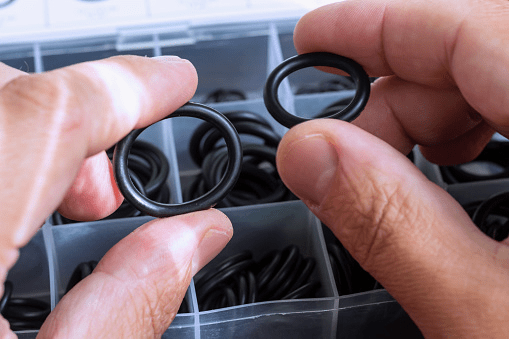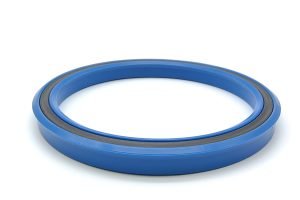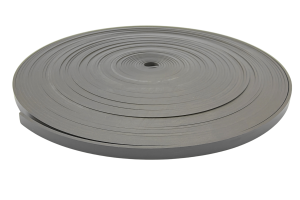
Gaskets and seals are regarded as the best sealants for industry and home use. A little you must know is that they seem similar but have various applications in multiple industries. These are sealing agents that are different in shape, use, and constituent materials. You will learn about the difference between gasket and seal in this blog.
That’s crucial information to get hands-on, as learning about them educates you about their core functionality and applications. Learn their detailed comparison below to make informed decisions.
1. Material Composition

Gaskets:generally incorporate pliable materials. However, the material choice needs careful consideration regarding factors like pressure, temperature, chemical resistance, etc. The key composition of the gasket includes:
- Rubber (such as EPDM, silicone, or nitrile)
- Metal (such as steel or aluminum)
- Cork
- Fiberglass
- Plastic polymers
- Polytetrafluoroethylene
Seals: have a material composition suitable for withstanding stress factors like extreme pressure and temperature, etc. They are perfect for dynamic applications that offer enhanced durability. The key composition of materials of the seal includes:
- Elastomers (such as Viton, silicone, polyurethane, EPDM, and nitrile)
- Metals (such as steel, copper, and aluminum)
- Thermoplastics (such as Polytetrafluoroethylene, Nylon, and Polyoxymethylene)
- Composite Materials (such as graphites)
- Natural Leathers
- Fiberglass
2. Design & Shape

Gaskets: You can use a gasket to fill the space between two static mating surfaces. Its strong sealing works when you apply a good compression. This layer of compression avoids leaking in different applications. Usually, they are flat but have different shapes and sizes with contours or thicknesses to fit different configurations. However, their common shapes include flat and rectangular shapes with the option of customized shapes.
Seals: Seals are more useful than gaskets in situations where two dynamic parts or mating surfaces need sealing. Furthermore, you can always observe the precise and well-defined shape of the seals. There are multiple designs of seals, e.g., U-shaped seals, V-shaped seals, Y-shaped seals, etc. You can also customize them in various required shapes.
3. Functions

Gaskets: A gasket stops the leak by forming a barrier between two sealing surfaces. Gaskets accommodate surface irregularities and maintain a seal even when the surfaces deform under extreme pressure and temperatures. In addition, you can compress them to use in between rough surfaces or to fill blank spaces between objects. If required, gaskets also act as vibration dampeners.
Seals: are used to avoid leaks between static and dynamic surfaces. That is why you can use them in moving components, e.g., rotating shafts, pistons sliding parts, etc. Their tolerance to extreme temperature and pressure is far better than gaskets. In addition, they are efficient to use in high-speed rotations.
Seals also protect machinery against dirt, water, and other pollutants that can affect the performance of machines.
4. Applications

The usage of gaskets is suitable where pressure and temperature are not high. In contrast, seals have improved applications for sealing dynamic equipment in an extreme temperature and pressure range.
Gaskets stick to the groves between the parts and guarantee a tight seal. Whereas, seals offer superior and fine sealing while allowing for movement. Furthermore, you can also use them to avoid noise and vibration in different components.
Both these sealing solutions have a range of applicability in industrial machinery. Their strong sealing ensures a working medium to avoid leaks.
Let’s take a peek at the areas of applications of both below:
| Applications | Gaskets | Seals |
| Automotive | Gaskets are the primary sealant for many automotive components. They include fuel, cooling, and transmission systems. | Seals are commonly used in vehicle suspension systems, brakes, drivetrain shafts, and crank or camshaft engine sealing. |
| Pharmaceuticals Industry | Gaskets are prevalent in sealing medical equipment like tubing systems and storage chambers. | Seals are used in aseptic processing, sealing product and equipment packaging, and in storage and transportation containers. |
| Food Processing | Gaskets help seal the shafts of food processing and packaging equipment, pipes, valve fittings, etc. | Seals are best for sealing food packaging lids and bags, food processing machinery, etc. |
| Aerospace | They are used in engine chambers, fuel shafts, and hydraulic and avionic systems of all aircraft. | Seals are common in sealing propulsion systems, landing gears, and aircraft environmental control systems. |
| Manufacturing Industry | Gaskets are suitable for preventing leaks in valve systems. They ensure the control of fluids in the machinery and chambers. | It is suitable for the production of hydraulic and pneumatic systems and compressors. Their strong sealing prevents leaking and other contaminations in the machinery. |
Table of Contents
ToggleFinal Verdict: Which One is the Best
You cannot declare a winner between a seal or a gasket. That’s because they are different in their functions and applications. Gaskets win where the sealing is required for static components. Whereas, seals are best suited for moving applications and can handle extreme pressure and temperature.
FAQs
1. What is the Way to Install a Seal or Gasket?
You need to properly install a respective seal or gasket to attain maximum performance. The general installation method includes cleaning surfaces, lubricant application, proper alignment, and compression. However, you can also follow the manufacturer’s instructions to install a seal or a gasket.
2. Can the Gakets or Seals Reused?
No, it is not recommended because a used gasket or seal is already compressed. Thus, could not provide an efficient seal. So, if you want an enhanced performance of your equipment, then use a new sealing agent.
3. Can I use a Seal or Gasket together in the Same Application?
Yes, you can use them together in the same application. It will provide a stronger sealing pattern and avert the seeping of water or fluids in an enhanced way.
More Resources
Gasket vs O-ring
What is Gasket? And Comprehensive Guide To Gaskets
How to Identify and Repairing Hydraulic Cylinder Seals







